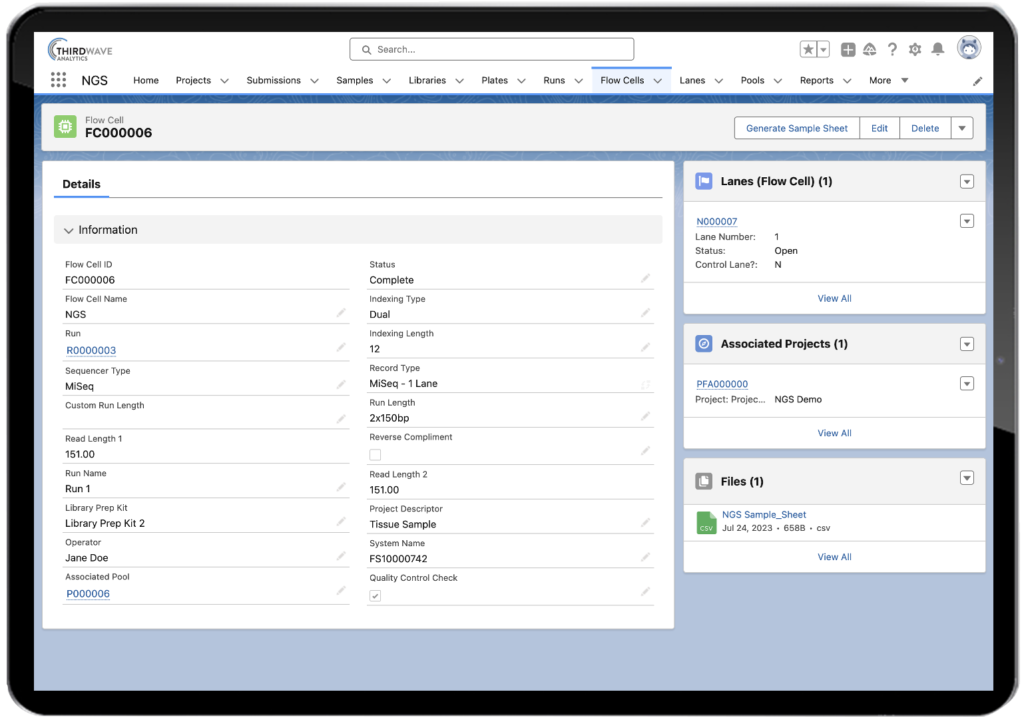Can a LIMS Solve Your Lab’s Sample Management Problems?
Have you ever accidentally copied the wrong index sequence onto your next-generation sequencing (NGS) sample tracking sheet?
Are you unsure which well you used from an index plate?
How about mistakenly including two samples in a pool with the same index or barcode sequence?
Worse yet, maybe you didn’t recognize you made one of these mistakes during your lab sample management process, and your data and sample integrity were compromised for your entire sequencing run.
If so, your lab can benefit from a LIMS system to help you modernize your business, introduce automation to your sample and inventory management, reduce common sample management workflow errors, and introduce new functionality to your sample collection, sample handling, and sample processing.
A comprehensive LIMS is most critical for clinical trial, biobanking, drug discovery, diagnostics, and life sciences industry laboratories.

Eliminate Common Sample Data Management Issues
The most common data management mistakes are easy to make – and cause you to re-prepare and re-sequence your libraries, which is a time-consuming headache that can be extremely expensive.
If you’re testing clinical samples, and your clinical sample management is compromised, the situation carries even more significant consequences in the form of delayed clinical results, which negatively impact patients.
Thankfully, there are ways to avoid these frustrating and costly errors by using a Laboratory Information Management System (LIMS) for automated sample management in your lab. With a LIMS, you can track your samples while preparing sequencing libraries and prevent issues before ever using your sequencing reagents.
What’s the right LIMS for your lab? What system characteristics are critical to eliminating sample management frustrations and maintaining a tight process with quality control and complete traceability?
When evaluating a LIMS, make sure it can tackle the following situations:
1. Accurately Track Index Sequences During Sequencing Library Preparation
Cutting down on manual data entry can help reduce or eliminate errors. A quality LIMS should have all the index sequences you use pre-loaded into the sample management system in your lab. Then, when you create new libraries, you can select from the index sequences that are already entered and available. This ensures no errors arise from manually entered sequences or copying and pasting them each time you prepare libraries.
A LIMS must also be able to help you quickly select the correct index for each sample you prepare. There should be simple methods to promptly choose the pre-loaded index plate and the well on the plate used for each sample in your batch.
With fewer manual steps in your process, you’ll prevent errors, maintain sample integrity, and see more effective sample management overall. You should never have to enter a sequence during sample tracking manually; the risk of error is too significant.
2. Check for Index-Clashing Within and Between Pools
Nothing is worse than realizing you’ve had an index clash – after your run is complete and you’re already reviewing data. A requirement for any LIMS is that the system automatically reviews all sample types and sample information in a sequencing pool to ensure no clashing index sequences occur.

At one time, avoiding these clashes was simpler because a pool consisted only of a handful of samples. But now, labs sequence hundreds of samples (from a large sample inventory) at a time.
It is now vital that any LIMS assess for index clashes within a batch of pooled samples and between any aggregated pools, making those complex super-pools. These super-pools present the most potential for error because multiple people often prepare them and don’t accurately communicate which indexes or barcodes were used.
A good LIMS must assess for indexes that clash between samples. This must occur within a single batch of pooled samples and between aggregated and sequenced pools as part of a complete tracking system.
3. Track Barcode and Index Sequences Simultaneously
The number of samples in a single sequencing run has become so large it is sometimes necessary to put both index and barcode sequences on samples. That’s great for throughput but challenging for your sample sheets.
If your workflow requires adding index and barcode sequences to each sample, your LIMS must account for both simultaneously. While your informatic process may deal with the indexes and barcodes simultaneously during data analysis, the combination of barcode and index must be tracked separately. If not, index clash-checking may be inaccurate.
Your LIMS should create a combined index/barcode sequence during the index-clashing assessment and validation. The entire combination will ensure an accurate estimate of your pooled sequencing libraries.
4. Generates the Sample Sheet for the Sequencer
Finally, one of the most essential characteristics of a modern LIMS and any sample management software is the ability to automatically generate the sample sheet used by the sequencer.
Nothing is more tedious or potentially error-prone than manually creating a sample sheet for a sequencing run containing hundreds of samples. How much time have you wasted creating these sample sheets and then trying to fix the errors?
Your LIMS should automatically generate this sheet in a format ready for use by your specific sequencer. Even minimal re-formatting should be avoided—a capable LIMS should generate your file in the exact format your sequencing instrument needs.
Overall, your LIMS should automatically generate a sample sheet your sequencer can use directly. You should never have to create these tedious documents again manually.

The Best LIMS for Sample Management: Top Takeaways
To avoid the nightmare scenarios that come with indexing your sequencing libraries, the right LIMS should do the following:
- Relieve you from manually entering an index sequence during sample tracking. All sequences are pre-loaded into the system and can be easily selected during library preparation.
- Warn of any potential index clashes between samples in a pool and between pools that are aggregated and sequenced.
- Use a combined barcode-and-index sequence for tracking and assessment of barcode sequences.
- Automatically generate a sample sheet that your sequencing instrument can immediately use.
As sequencing libraries become more complex, a LIMS plays an increasingly vital role in accurately processing samples. Selecting the right LIMS helps reduce and eliminate errors and streamlines your sequencing library index workflow. You gain greater confidence, time, and money by preventing unnecessary mistakes.
Opportunities with Lockbox LIMS
To see how Lockbox LIMS can help you manage your library indexing process, contact us here, and our sales team will be in touch.
If you are a current Lockbox LIMS subscriber and think your team could benefit from the Lockbox NGS module, please get in touch with your Customer Success Rep.